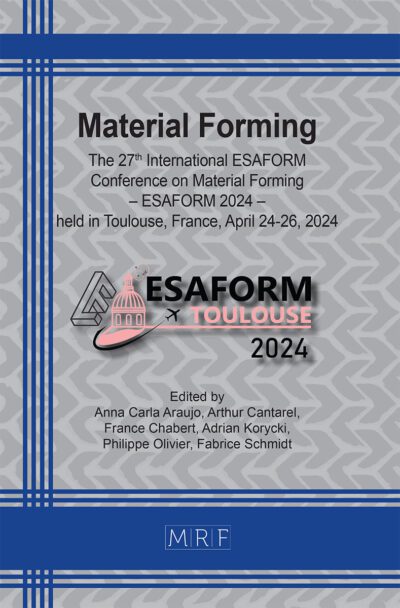Seismic assessment of masonry infilled frame structures
Galal AL-MEKHLAFI, Mohammed AL-OSTA, Hamdi AL-SAKKAF
Abstract. Some existing residential buildings have not been designed to withstand potential earthquakes, making it crucial to evaluate the impact of infill walls on their seismic performance. This study focuses on the seismic evaluation of unreinforced masonry infilled reinforced concrete (RC) frames using a micro-modeling approach with ABAQUS software. Two types of infill walls were examined: one consisting of a stone masonry layer and concrete blocks, and another composed solely of concrete blocks. The study generated nonlinear force-displacement curves to illustrate the impact of infill walls on structural stiffness. Results showed that both types of infill significantly enhance lateral stiffness and reduce drift demands, demonstrating their critical role in the seismic performance of infilled frames.
Keywords
Seismic Evaluation, Infilled RC Frames, Lateral Stiffness, Finite Element Analysis
Published online 2/25/2025, 9 pages
Copyright © 2025 by the author(s)
Published under license by Materials Research Forum LLC., Millersville PA, USA
Citation: Galal AL-MEKHLAFI, Mohammed AL-OSTA, Hamdi AL-SAKKAF, Seismic assessment of masonry infilled frame structures, Materials Research Proceedings, Vol. 48, pp 191-199, 2025
DOI: https://doi.org/10.21741/9781644903414-22
The article was published as article 22 of the book Civil and Environmental Engineering for Resilient, Smart and Sustainable Solutions
![]() Content from this work may be used under the terms of the Creative Commons Attribution 3.0 license. Any further distribution of this work must maintain attribution to the author(s) and the title of the work, journal citation and DOI.
Content from this work may be used under the terms of the Creative Commons Attribution 3.0 license. Any further distribution of this work must maintain attribution to the author(s) and the title of the work, journal citation and DOI.
References
[1] R. Falcão Moreira, H. Varum, and J. M. Castro, “Influence of Masonry Infill Walls on the Seismic Assessment of Non-Seismically Designed RC Framed Structures,” Buildings, vol. 13, no. 5, May 2023. https://doi.org/10.3390/buildings13051148
[2] J. Dias-Oliveira, H. Rodrigues, P. Asteris, and H. Varum, “On the Seismic Behavior of Masonry Infilled Frame Structures,” Buildings, vol. 12, no. 8, p. 1146, Aug. 2022. https://doi.org/10.3390/buildings12081146
[3] A. Kauffman and A. Memari, “Performance Evaluation of Different Masonry Infill Walls with Structural Fuse Elements Based on In-Plane Cyclic Load Testing,” Buildings, vol. 4, no. 4, pp. 605–634, Sep. 2014. https://doi.org/10.3390/buildings4040605
[4] S. kumar D. Dubey and S. Kute, “An experimental investigation on the ultimate strength of epoxy-repaired braced partial infilled RC frames,” International Journal of Advanced Structural Engineering, vol. 6, no. 1, p. 3, Mar. 2014. https://doi.org/10.1186/2008-6695-6-3
[5] A. Mansouri, M. S. Marefat, and M. Khanmohammadi, “Experimental evaluation of seismic performance of low‐shear strength masonry infills with openings in reinforced concrete frames with deficient seismic details,” The Structural Design of Tall and Special Buildings, vol. 23, no. 15, pp. 1190–1210, Oct. 2014. https://doi.org/10.1002/tal.1115
[6] “FEMA. NEHRP Commentary on the Guidelines for the Seismic Rehabilitation of Buildings; FEMA-274; Applied Technology Council: Washington, DC, USA, 1997.”
[7] “FEMA. Prestandard and Commentary for the Seismic Rehabilitation of Buildings; Federal Emergency Management Agency: Washington, DC, USA, 2000.”
[8] A. Fiore, A. Netti, and P. Monaco, “The influence of masonry infill on the seismic behaviour of RC frame buildings,” Eng Struct, vol. 44, pp. 133–145, Nov. 2012. https://doi.org/10.1016/j.engstruct.2012.05.023
[9] M. A. Najafgholipour, F. Behrouzi, and R. Hassanli, “Performance of masonry infills in reinforced concrete moment resisting frames under bidirectional seismic excitations,” Bulletin of Earthquake Engineering, vol. 22, no. 4, pp. 1749–1774, Mar. 2024. https://doi.org/10.1007/s10518-023-01830-8
[10] A. Zine, A. Kadid, and A. Zatar, “Effect of masonry infill panels on the seismic response of reinforced concrete frame structures,” Civil Engineering Journal (Iran), vol. 7, no. 11, pp. 1853–1867, Nov. 2021. https://doi.org/10.28991/cej-2021-03091764
[11] Y. Sanada and M. Maidiawati, “Modeling for interactions between R/C column and masonry infill interactions between R/C column and masonry,” Journal of Structural and Construction Engineering, vol. 79, no. 695, pp. 173–180, 2014. https://doi.org/10.3130/aijs.79.173
[12] M. Yekrangnia and P. G. Asteris, “Multi-strut macro-model for masonry infilled frames with openings,” Journal of Building Engineering, vol. 32, p. 101683, Nov. 2020. https://doi.org/10.1016/j.jobe.2020.101683
[13] J. Lubliner, J. Oliver, S. Oller, and E. Oñate, “A plastic-damage model for concrete,” Int J Solids Struct, vol. 25, no. 3, pp. 299–326, 1989. https://doi.org/10.1016/0020-7683(89)90050-4
[14] American Society of Civil Engineers, Minimum Design Loads and Associated Criteria for Buildings and Other Structures, ASCE/SEI 7-22, Reston, VA: ASCE, 2022
[15] L. S. Rainone, V. Tateo, S. Casolo, and G. Uva, “About the Use of Concrete Damage Plasticity for Modeling Masonry Post-Elastic Behavior,” Buildings, vol. 13, no. 8, p. 1915, Jul. 2023. https://doi.org/10.3390/buildings13081915 (buildings-13-01915-v2)
[16] N. Ravichandran, D. Losanno, and F. Parisi, “Comparative assessment of finite element macro modelling approaches for seismic analysis of non engineered masonry constructions,” Bulletin of Earthquake Engineering, vol. 19, no. 9, pp. 5565-5607, 2021. https://doi.org/10.1007/s10518-021-01180-3 (s10518-021-01180-3 (2))
[17] A. Wosatko, A. Winnicki, M. A. Polak, and J. Pamin, “Role of dilatancy angle in plasticity-based models of concrete,” Arch. Civ. Mech. Eng., vol. 19, pp. 1-16, 2019. https://doi.org/10.1016/j.acme.2019.07.003













